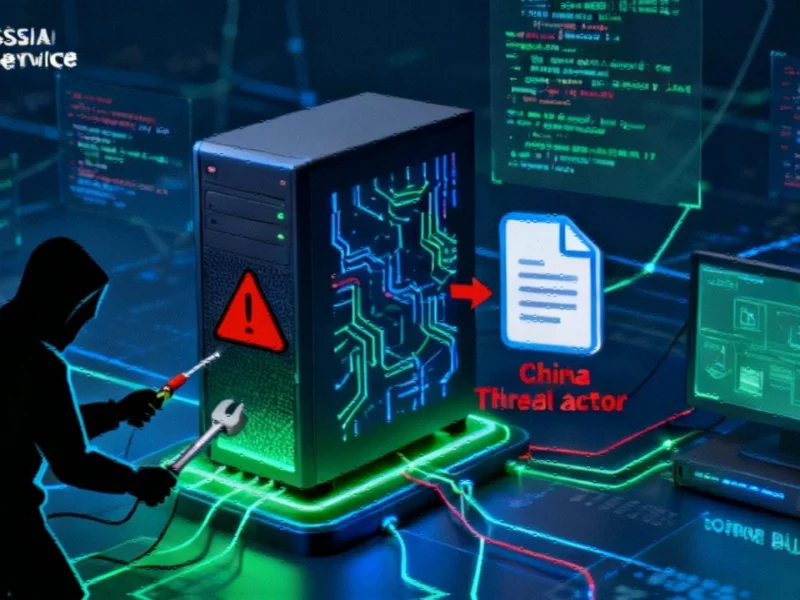Sophisticated Cyber Espionage Campaign Uncovered
Security researchers have uncovered new evidence linking the notorious Chinese hacking collective Salt Typhoon to sophisticated intrusions targeting European telecommunications infrastructure. The group, known for its persistent cyber espionage operations against global communications networks, has been detected using advanced stealth techniques to infiltrate critical systems., according to market analysis
Table of Contents
Darktrace’s latest threat intelligence report reveals that Salt Typhoon has been “targeting global infrastructure using stealthy techniques such as DLL sideloading and zero-day exploits” in a campaign that mirrors their previous extensive operations against US telecommunications providers.
Historical Pattern of Telecommunications Targeting
This latest activity follows Salt Typhoon’s previously documented campaign against US telecommunications networks, where the group successfully breached up to eight different telecom organizations in a multi-year operation. That campaign resulted in the compromise of millions of American telecom customers’ data through exploitation of a high-severity Cisco vulnerability.
The group demonstrated remarkable persistence in their US operations, using the initial access to eventually collect network traffic from connected devices, highlighting their sophisticated intelligence-gathering capabilities and long-term strategic objectives., according to market analysis
Latest European Intrusion Tactics
In the newly discovered European campaign, Darktrace assessed with moderate confidence that Salt Typhoon abused legitimate tools with stealth and persistence, specifically exploiting a Citrix NetScaler Gateway appliance to gain initial access to target networks., according to market analysis
Following initial compromise, the threat actors deployed Snappybee malware, also known as Deed RAT, using a technique called DLL side-loading. This method has become increasingly common among Chinese state-sponsored threat actors seeking to evade traditional security measures.
Advanced Evasion Techniques
The backdoor was delivered to internal endpoints as a DLL alongside legitimate executable files for well-known antivirus software including Norton Antivirus, Bkav Antivirus, and IObit Malware Fighter.
“This pattern of activity indicates that the attacker relied on DLL side-loading via legitimate antivirus software to execute their payloads,” Darktrace explained in their analysis. “Salt Typhoon and similar groups have a history of employing this technique, enabling them to execute payloads under the guise of trusted software and bypassing traditional security controls.”
Successful Detection and Mitigation
Fortunately, in this instance, the intrusion was identified and remediated during the early stages of the attack lifecycle, preventing further escalation and potential damage. The successful detection highlights the critical importance of advanced, behavior-based security monitoring rather than relying solely on traditional signature-based detection methods.
This case demonstrates that while sophisticated state-sponsored threat actors continue to evolve their techniques, advanced detection capabilities can effectively neutralize threats before they achieve their ultimate objectives., as covered previously
Implications for Critical Infrastructure Protection
The repeated targeting of telecommunications infrastructure by advanced persistent threat groups underscores the strategic value these networks represent for nation-state actors. Telecommunications systems provide not only valuable intelligence through intercepted communications but also potential access to countless connected organizations and individuals.
Security experts emphasize that organizations operating critical infrastructure must adopt proactive, anomaly-based defense and detection strategies to counter the growing sophistication of state-sponsored cyber operations. The evolving threat landscape demands continuous monitoring for subtle behavioral anomalies rather than relying exclusively on known threat signatures.
For detailed technical analysis of this threat activity, security professionals can reference Darktrace’s comprehensive research on Salt Typhoon’s latest intrusion methods.
Related Articles You May Find Interesting
- Real-World Encounters Trump Digital Echo Chambers in Predicting Election Outcome
- Magnetic Alloy Breakthrough Unlocks Next-Generation Hydrogen Fuel Cell Efficienc
- The AI Alignment Imperative: How CFOs Can Unlock Enterprise Value by Bridging Fi
- Scientists Warn Solar Geoengineering Faces Major Practical Hurdles Beyond Climat
- How Carbon Trading Reshapes Construction Efficiency: A Deep Dive into China’s Gr
References & Further Reading
This article draws from multiple authoritative sources. For more information, please consult:
- https://www.darktrace.com/blog/salty-much-darktraces-view-on-a-recent-salt-typhoon-intrusion
- https://futureplc.com/terms-conditions/
- https://futureplc.com/privacy-policy/
- https://hawk.ly/m/bitdefender-total-security/i/techradar-onsite-bg-antivirus
- https://hawk.ly/m/norton-360-with-lifelock-select/i/techradar-onsite-bg-antivirus
- https://hawk.ly/m/mcafee-mobile-security/i/techradar-onsite-bg-antivirus
This article aggregates information from publicly available sources. All trademarks and copyrights belong to their respective owners.
Note: Featured image is for illustrative purposes only and does not represent any specific product, service, or entity mentioned in this article.



